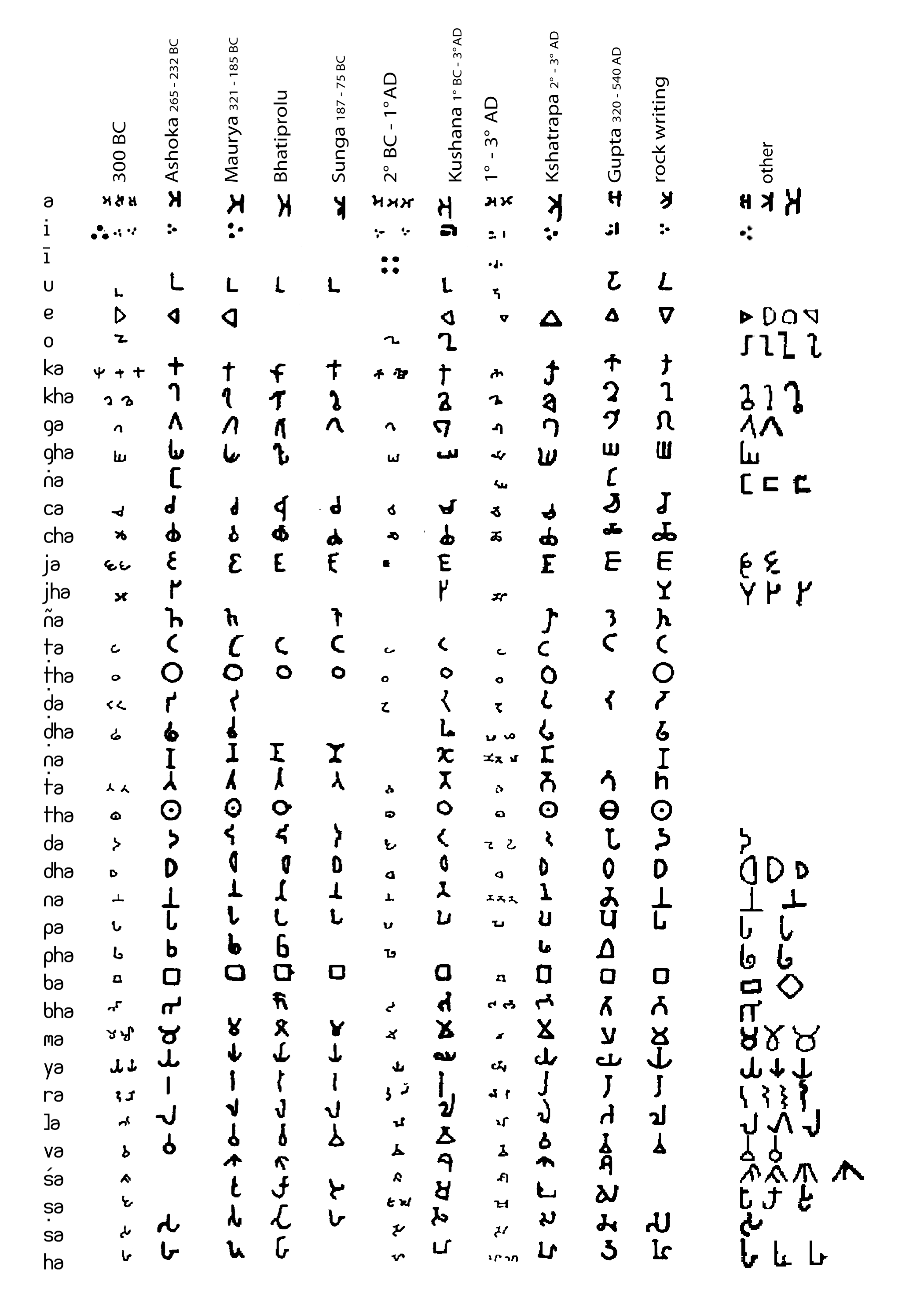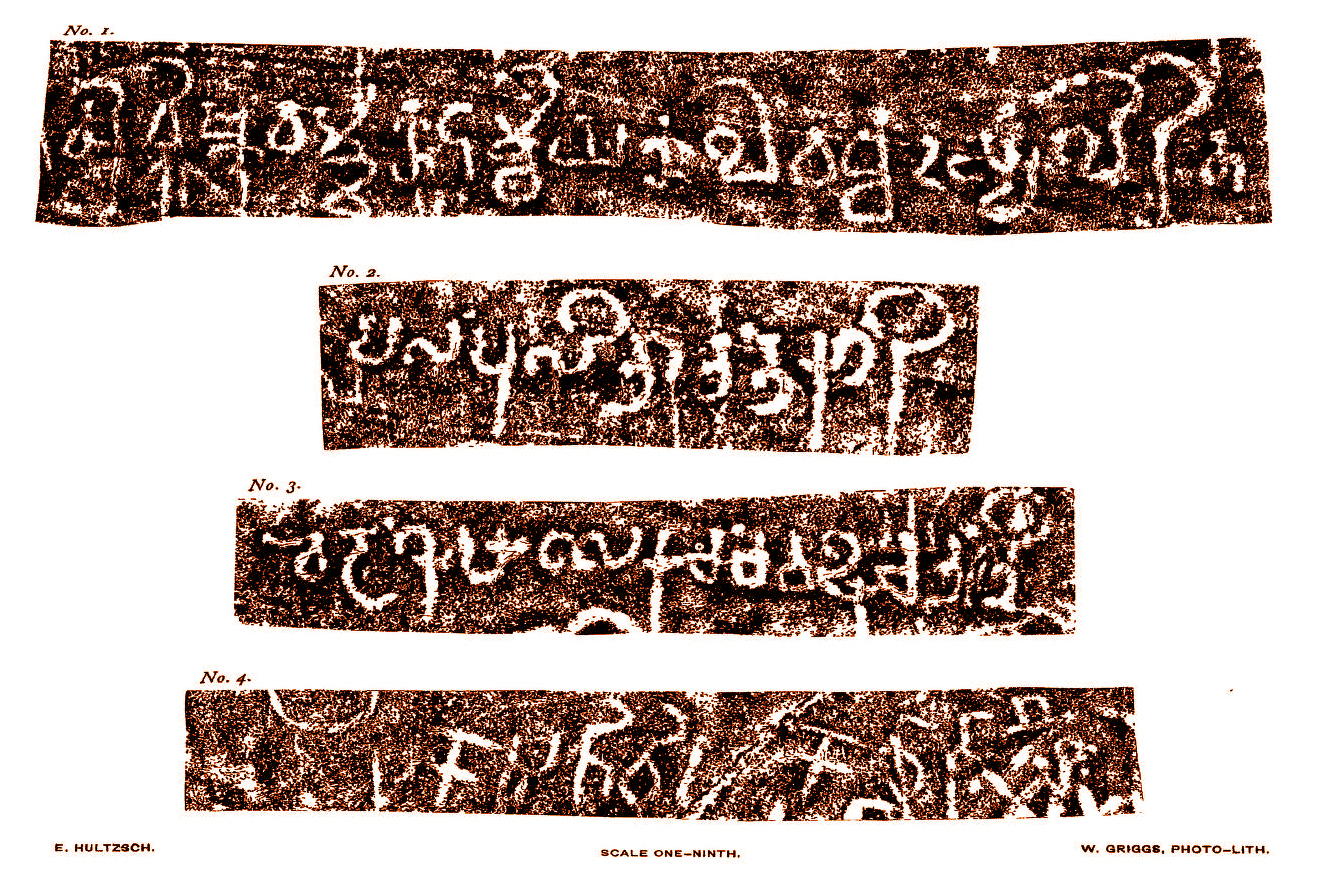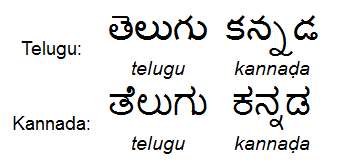|
Salankayana Dynasty
The Salankayana (IAST: Śālaṇkāyana) dynasty of ancient India ruled a part of Andhra region in India from 300 to 440 CE. Their territory was located between the Godavari and the Krishna rivers. Their capital was located at Vengi, modern Pedavegi near Eluru in West Godavari district of Andhra Pradesh. Salankayana is a Brahmin Sage. Their name is derived from their symbol and gotra name, which stood for Nandi (the bull of Shiva). The Salankayanas succeeded the Andhra Ikshvaku dynasty and were vassals of the Pallava kings of southern India. During their time the script for Telugu began to clearly separate from that of the other South Indian and North Indian languages. Hastivarman, the first king, was one of the many kings who were defeated by Samudragupta, but were later released and paid him tribute. The verse from the Allahabad stone pillar inscription of Samudragupta which mentions Hastivarma: * (Lines 19–20) Whose magnanimity blended with valour was caused by (his) fir ... [...More Info...] [...Related Items...] OR: [Wikipedia] [Google] [Baidu] |
IAST
The International Alphabet of Sanskrit Transliteration (IAST) is a transliteration scheme that allows the lossless romanisation of Indic scripts as employed by Sanskrit and related Indic languages. It is based on a scheme that emerged during the nineteenth century from suggestions by Charles Trevelyan, William Jones, Monier Monier-Williams and other scholars, and formalised by the Transliteration Committee of the Geneva Oriental Congress, in September 1894. IAST makes it possible for the reader to read the Indic text unambiguously, exactly as if it were in the original Indic script. It is this faithfulness to the original scripts that accounts for its continuing popularity amongst scholars. Usage Scholars commonly use IAST in publications that cite textual material in Sanskrit, Pāḷi and other classical Indian languages. IAST is also used for major e-text repositories such as SARIT, Muktabodha, GRETIL, and sanskritdocuments.org. The IAST scheme represents more than a ... [...More Info...] [...Related Items...] OR: [Wikipedia] [Google] [Baidu] |
Bhattiprolu Script
The Bhattiprolu script is a variant of the Brahmi script which has been found in old inscriptions at Bhattiprolu, a small village in Guntur district, Andhra Pradesh, South India. It is located in the fertile Krishna river delta and the estuary region where the river meets the Bay of Bengal. The inscriptions date to between the 3rd and 1st centuries BCE, putting them among the earliest evidence of Brahmi writing in South India. Bhattiprolu differs from Ashokan Brahmi in two significant ways. First, the letters ''gh, j, m, l, s'' are "radically different": ''m'' is upside-down compared to Brahmi, while ''gh'' appears to derive from ''g'' rather than from Semitic ''heth''. Secondly, the inherent vowel has been discarded: A consonant written without diacritics represents the consonant alone. This is unique to Bhattiprolu and Tamil Brahmi among the early Indian scripts. Discovery Excavations that started in the year 1870 by Boswell, Sir Walter Elliot, Robert Sewell, Alexande ... [...More Info...] [...Related Items...] OR: [Wikipedia] [Google] [Baidu] |
Kadamba Script
The Kadamba script is the first writing system devised specifically for writing Kannada and Telugu. It is a descendant of the Brahmi script. The Kadamba script is also known as ''Pre-Old-Kannada script''. The Kadamba script is one of the oldest of the southern group of Brahmic scripts that evolved from the Brahmi script. By the 5th century CE it became distinct from other Brahmi variants and was used in southern Indian states of Karnataka and Andhra Pradesh. It evolved into the Old Kannada script by the 10th century CE and was used to write Kannada and Telugu. It is also related to the Sinhala script. History During the rule of Kadamba dynasty (325-550), major change in the Brahmi script resulted in the Kadamba Kannada script, letters were shorter and round in shape. During (325 to 1000 AD) the rule of the Western Ganga dynasty in the southern parts of Karnataka the Kannada script used differently (also known as Ganga script) in rock edicts and copper plate inscriptions. Du ... [...More Info...] [...Related Items...] OR: [Wikipedia] [Google] [Baidu] |
Telugu-Kannada Script
The Kannada–Telugu script (or Telugu–kannada script) was a writing system used in Southern India. Despite some differences, the scripts used for the Kannada and Telugu languages remain quite similar and highly mutually intelligible. History The Dravidian family comprises about 73 languages including Tamil, Kannada, Telugu and Malayalam. Satavahanas introduced the Brahmi to present-day Telugu and Kannada speaking regions. Bhattiprolu script introduced by the Satavahanas gave rise to the Kadamba script. During the 5th to 7th centuries the early Bādāmi Chālukyās and Early Banavasi Kadambās used an early form of the Kannada script in inscriptions, called the Kadamba script. The Kadamba script evolved into the Kannada script. When Chalukya empire extended towards Telugu speaking regions they establihed another branch in Vengi, namely the Eastern Chalukyas or the Chalukyas of Vengi who later introduced Kannada script to Telugu language which devloped Kannada-Telugu script ... [...More Info...] [...Related Items...] OR: [Wikipedia] [Google] [Baidu] |
Telugu Brahmins
Telugu Brahmins are Brahmin communities native to the Indian states of Andhra Pradesh and Telangana. History Origin theories According to the ''Aitareya Brahmana'' of the Rigveda, the Andhras left north India from the banks of the River Yamuna around 800 BCE and migrated into peninsular India. Telugu Brahmins are also called Andhras. Classification Telugu Brahmins fall under the Pancha Dravida Brahmin classification of the Brahmin community in India. The Brahmins of Andhra Pradesh and Telangana mainly include Vaidikis, Niyogis, Deshasthas, Telugu Madhvas, Golkanda Vyaparis, Dravidulu. They are divided on the basis of Vedic traditions that they follow such as Smartha, Madhva, and Sri Vaishnava. Vaidikis and Niyogis are mainly Smarthas, while Sri Vaishnavas and Telugu Madhvas are Telugu Brahmins who converted to Ramanuja and Madhvacharya faith respectively. Telugu Madhvas and Deshastha Madhvas are mainly followers of Uttaradi Matha, Raghavendra Matha and Vyasaraja Matha, Whil ... [...More Info...] [...Related Items...] OR: [Wikipedia] [Google] [Baidu] |
Vishnukundinas
The Vishnukundina dynasty (IAST: Viṣṇukundina) was an Indian dynasty based in Deccan Plateau, Deccan, which ruled modern Andhra Pradesh, Telangana, Odisha and parts of South India during the 5th and 6th centuries, carving land out from the Vakataka, Vakataka Empire. It played an important role in the history of the Deccan during the 5th and 6th centuries. The dynasty initially ruled from Indrapalanagara (in present day Nalgonda district of Telangana), and later shifted to Denduluru, and Amaravathi, Guntur district, Amaravathi. The area north of the Godavari River, Godavari, Kalinga (historical region), Kalinga became independent, the area south of the Krishna River fell to the Pallavas. The Vishnukundina reign came to an end with the conquest of the eastern Deccan by the Chalukya, Pulakeshin II. Pulakeshi appointed his brother Kubja Vishnuvardhana as viceroy to rule over the conquered lands. Eventually, Vishnuvardhana declared his independence and started the Eastern Chalukya ... [...More Info...] [...Related Items...] OR: [Wikipedia] [Google] [Baidu] |
Madhava Varma II
Madhava Varma II was the most successful ruler of the Vishnukundina dynasty, controlling parts of the Deccan and eastern coast of India in the mid-5th century AD. He is regarded as the greatest ruler of his dynasty. The Vishnukundina Empire reached its greatest territorial extent under him. It was during this period the Vishnukundina dynasty was raised, in its own estimation, to the imperial dignity.Krishna Eao, B.V., 1942; Early Dynasties of the Andhra Desa, Madras; pp.422-427. The most notable military achievement of Madhava Varma II was his victory over the Vakataka emperor Prithvishena II. The daughter of Prithvishena II, Vakataka Mahadevi, was given in marriage to Madhava Varma II. Early life He was the son of Govinda Varma I and his wife Mahadevi. He had two sons - Vikramendra Varma and Deva Varma. Reign His predecessor was Madhava Varma I (c. 420 – c. 455). He is considered as the greatest ruler of the Vishnukundina dynasty. The Vishnukundina Empire reached its grea ... [...More Info...] [...Related Items...] OR: [Wikipedia] [Google] [Baidu] |
Salankayana
The Salankayana (IAST: Śālaṇkāyana) dynasty of ancient India ruled a part of Andhra region in India from 300 to 440 CE. Their territory was located between the Godavari and the Krishna rivers. Their capital was located at Vengi, modern Pedavegi near Eluru in West Godavari district of Andhra Pradesh. Salankayana is a Brahmin Sage. Their name is derived from their symbol and gotra name, which stood for Nandi (the bull of Shiva). The Salankayanas succeeded the Andhra Ikshvaku dynasty and were vassals of the Pallava kings of southern India. During their time the script for Telugu began to clearly separate from that of the other South Indian and North Indian languages. Hastivarman, the first king, was one of the many kings who were defeated by Samudragupta, but were later released and paid him tribute. The verse from the Allahabad stone pillar inscription of Samudragupta which mentions Hastivarma: * (Lines 19–20) Whose magnanimity blended with valour was caused by (his) fir ... [...More Info...] [...Related Items...] OR: [Wikipedia] [Google] [Baidu] |
Vishnugopa
Vishnugopa (IAST: Viṣṇugopa) was a Pallava king of Kanchi. He was the son of Buddhavarman. He was one of the kings defeated by Gupta Emperor Samudragupta during his southern expedition. Mayurasharma established Kadamba dynasty taking advantage of the weakening of the Pallava power. A verse (lines 19–20) from the Allahabad stone pillar inscription of Samudragupta Allahabad (), officially known as Prayagraj, also known as Ilahabad, is a metropolis in the Indian state of Uttar Pradesh.The other five cities were: Agra, Kanpur (Cawnpore), Lucknow, Meerut, and Varanasi (Benares). It is the admini ... mentions Vishnugopa: References Pallava dynasty Tamil monarchs {{India-royal-stub ... [...More Info...] [...Related Items...] OR: [Wikipedia] [Google] [Baidu] |
Pithapuram
Pithapuram, historically known as Pittapore, is a town and a municipality in the Kakinada district in the Indian state of Andhra Pradesh. The town also forms a part of Godavari Urban Development Authority. The town is home to one of the eighteen Maha Sakthi Peethas, which are significant shrines and pilgrimage destinations in Shaktism. Sripada Sri Vallabha, a prominent Hindu saint of 14th century was born and lived in Pithapuram. He is considered by his devotees as one of the first complete avatars (incarnations) of the deity Dattatreya in Kali Yuga. History Pithapuram was originally called Pithikapuram. The earliest extant inscription to mention the city is the fourth century king Samudragupta's Allahabad Pillar inscription, which states that he defeated the king Mahendra of Pithikapuram. The inscriptions of the fourth and fifth century Vasishtha and Mathara dynasties also mention Pishtapura, describing it as a part of Kalinga. In the seventh century, the Chalukya king ... [...More Info...] [...Related Items...] OR: [Wikipedia] [Google] [Baidu] |
Dakshina Kosala
Dakshina Kosala (IAST: Dakṣiṇa Kosala, "southern Kosala") is a historical region of central India. It was located in what is now Madhya Pradesh and Chhattisgarh along with some parts of Western Odisha. At its greatest extent, it may have also included a part of the Vidarbha region in present-day Maharashtra. Its capitals at various times included Bhadravati, Sirpur (ancient Shripura), Tuman (ancient Tummana), and Ratanpur (ancient Ratnapura). Extent Dakshina Kosala ("South Kosala"), sometimes simply called Kosala, is so-called to distinguish it from Uttara Kosala ("North Kosala") in present-day Uttar Pradesh. Epigraphic evidence suggests that the area bounded by the Shahdol, Raipur, Bilaspur, Anuppur Sambalpur districts was definitely a part of the Dakshina Kosala region. The inscriptions found in these districts record grants of villages located in the Kosala country, and the rulers mentioned in these inscriptions are given the titles indicating their lordship ove ... [...More Info...] [...Related Items...] OR: [Wikipedia] [Google] [Baidu] |



